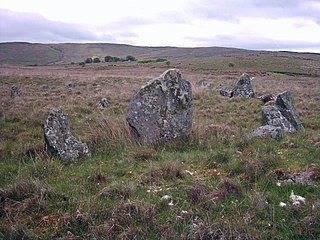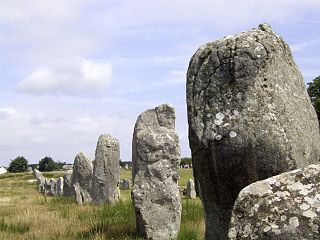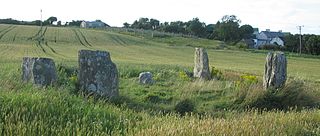
The Avinagillan standing stone is a prehistoric menhir on the Kintyre Peninsula of Scotland. The stone is near the hamlet of Avinagillan. [1]

The Avinagillan standing stone is a prehistoric menhir on the Kintyre Peninsula of Scotland. The stone is near the hamlet of Avinagillan. [1]

The Clava cairn is a type of Bronze Age circular chamber tomb cairn, named after the group of three cairns at Balnuaran of Clava, to the east of Inverness in Scotland. There are about 50 cairns of this type in an area round about Inverness. They fall into two sub-types, one typically consisting of a corbelled passage grave with a single burial chamber linked to the entrance by a short passage and covered with a cairn of stones, with the entrances oriented south west towards midwinter sunset. In the other sub-type an annular ring cairn encloses an apparently unroofed area with no formal means of access from the outside. In both sub-types a stone circle surrounds the whole tomb and a kerb often runs around the cairn. The heights of the standing stones vary in height so that the tallest fringe the entrance and the shortest are directly opposite it.

Corick is a megalithic site and townland in the civil parish of Ballynascreen, County Londonderry, Northern Ireland. It includes a stone circle and a stone row. The Corick stone circles and alignments are located 2 km north east of Ballybriest court-tomb, 400 metres south of Corick clachan, near a stream. There are some 5 circles and 3 stone-rows. The stone alignments and circle are Scheduled Historic Monuments in Corick at grid reference: Area of H780 896.

Ballochroy is a megalithic site in Kintyre on the Argyll peninsula in Scotland. It consists of three vertical stones, side by side, aligned with various land features 7–19 miles (11–31 km) away.

The Callanish II stone circle is one of many megalithic structures around the better-known Calanais I on the west coast of the Isle of Lewis, in the Outer Hebrides, Scotland.

The Callanish III stone circle is one of many megalithic structures around the better-known Calanais I on the west coast of the Isle of Lewis, in the Outer Hebrides, Scotland.

The Carnac stones are an exceptionally dense collection of megalithic sites in Brittany in northwestern France, consisting of stone alignments (rows), dolmens, tumuli and single menhirs. More than 3,000 prehistoric standing stones were hewn from local granite and erected by the pre-Celtic people of Brittany, and form the largest such collection in the world. Most of the stones are within the Breton village of Carnac, but some to the east are within La Trinité-sur-Mer. The stones were erected at some stage during the Neolithic period, probably around 3300 BCE, but some may date to as early as 4500 BCE.

Annathill is a small village located near Coatbridge in North Lanarkshire, Scotland, although closer to Glenboig. The name "Annathill" is thought to be derived from a patron saint's church. Annathill is on the banks of the Mollins Burn, a tributary of the Luggie Water.

Knocknakilla is the site of a megalithic complex situated between Macroom and Millstreet, in County Cork, Ireland. It is set in blanket peatland on the north-west upper slopes of Musherabeg mountain and is thought to be 3500 years old.

Templebryan Stone Circle is a stone circle, located 2.5 km (1.6 mi) north of Clonakilty, County Cork, Ireland. Grid ref: W386 438. Close by lies an Early Christian site.

Glantane East is a megalithic complex situated 6.4 kilometres (4.0 mi) from Millstreet, County Cork, Ireland. It is set in the Keel River valley on the north-west upper slopes of Musherabeg mountain, in the townland of Glantane. The complex includes a wedge tomb, two stone circles and a pair of stone alignments.

The Uragh Stone Circle is a stone circle near Gleninchaquin Park, Tuosist, County Kerry, Ireland.

Balfour Castle is a historic building on the southwest of Shapinsay, Orkney Islands. Though built around an older structure that dates at least from the 18th century, the present castle was built in 1847, commissioned by Colonel David Balfour, and designed by Edinburgh architect David Bryce. It is a Category A listed building and the landscape and formal gardens are listed in the Inventory of Gardens and Designed Landscapes in Scotland.

Sheldon Stone Circle is a prehistoric stone circle, located at grid reference NJ822249, to the south-east of Oldmeldrum, Aberdeenshire, Scotland.

Castle Bloody is a prehistoric feature on the island of Shapinsay, Orkney, Scotland. Hogan observes that while the feature is marked as a chambered mound on the UK Ordnance Survey map, the structure is more properly and specifically classified as a souterrain or earth house. Slightly to the north is located the ruined historic Linton Chapel.
The Mill of Morphie is a historic waterwheel in Aberdeenshire, Scotland. The Mill of Morphie is situated nearby to the Stone of Morphie, an unshaped extant standing stone.

Dun Skeig is an oval Iron Age dun (fort) complex which is perched atop a rocky outcropping about 40 metres (130 ft) above sea level overlooking West Loch Tarbert in Kintyre, Argyll and Bute, Scotland, about 1 kilometre (0.62 mi) northwest of the village of Clachan.

Brotherstone Hill is a hill near St. Boswells and the Eildon Hills in the Scottish Borders area of Scotland, with two standing stones from the megalithic age, on the summit of Brotherstone Hill, at a height of 418 metres. The stones differ in height and stand 16 metres apart. The stones mark the boundary between the old Borders counties of Roxburghshire and Berwickshire.

Balquhain, also known as Balquhain Stone Circle, The Chapel of Garioch or Inveramsay, is a recumbent stone circle 3 miles (4.8 km) from Inverurie in Scotland. It is a scheduled ancient monument.

Trefignath is a Neolithic burial chamber near Trearddur, south of Holyhead on Holy Island, off Anglesey in Wales. In its most complete form it included a large cairn covering three stone tombs, set on a small knoll. It was excavated between 1977 and 1979, revealing several phases of occupation with three separate burial chambers built in succession. It is a scheduled ancient monument, maintained by Cadw.
Midmar is a historic settlement in Aberdeenshire north of Banchory and southwest of Inverurie, 15 miles west of Aberdeen. It is noted for its three stone circles and several standing stones.
Coordinates: 55°51′06″N5°27′14″W / 55.85175°N 5.45396°W
| This Scottish history-related article is a stub. You can help Wikipedia by expanding it. |